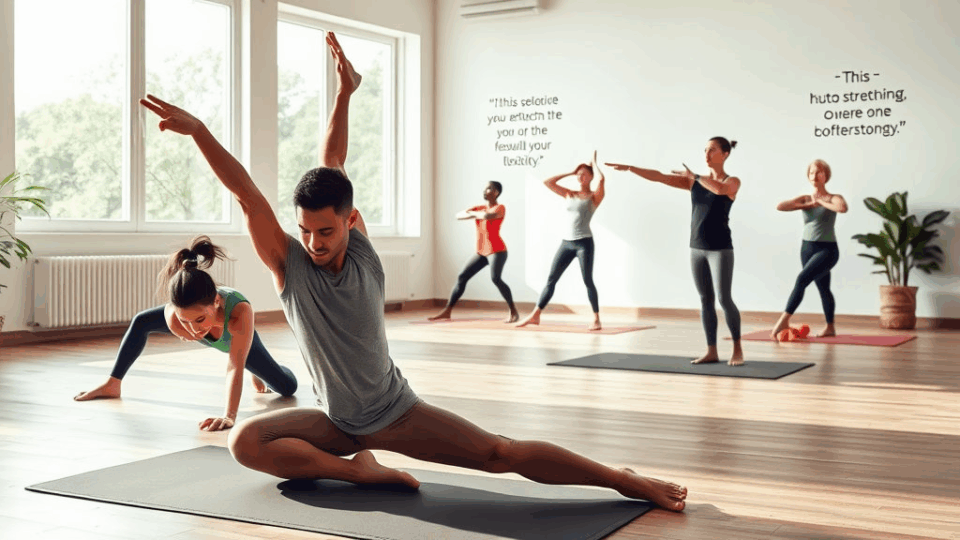
Effective Stretching Techniques and Why They Matter
Dynamic Stretching Before Your Workout

Before you jump into your workout, taking a few minutes for dynamic stretching can make a world of difference. Unlike static stretching, which involves holding a position for a period of time, dynamic stretching is all about movement. It helps warm up your muscles, increases your heart rate, and prepares your body for the physical activity ahead.
Dynamic stretches mimic the movements of the workout you’re about to do, making them more effective in preventing injuries and improving performance. For example, leg swings, arm circles, walking lunges, and torso twists are great ways to activate your muscles and joints. These movements enhance your range of motion, improve circulation, and help your nervous system get ready for action.
Incorporating dynamic stretching into your pre-workout routine can also boost your mental focus. As your body starts to move, your brain becomes more alert, helping you stay sharp and engaged during your workout. Whether you’re heading into a run, strength training, or a yoga session, dynamic stretching is a gentle yet powerful way to prime your body and mind.
So next time you lace up your sneakers, remember to give your body the warm-up it deserves. A few minutes of dynamic stretching can lead to better performance, fewer injuries, and a more enjoyable workout experience.
Static Stretching for Recovery

After a long day or an intense workout, your muscles deserve a little extra love—and that’s where static stretching comes in. Static stretching involves holding a stretch for a period of time, usually between 15 to 60 seconds, allowing your muscles to gently lengthen and relax. Unlike dynamic stretching, which is best for warming up, static stretching is ideal for cooling down and aiding in recovery.
When you stretch statically after exercise, you help reduce muscle tension, improve flexibility over time, and even decrease the risk of injury. It also promotes better blood circulation, which is essential for delivering nutrients to tired muscles and flushing out waste products like lactic acid. This means less soreness and faster recovery.
Incorporating static stretching into your post-workout routine can also be a great way to wind down mentally. Taking a few quiet moments to breathe deeply and stretch can help calm your nervous system and reduce stress levels.
Some effective static stretches include the seated hamstring stretch, standing quad stretch, and child’s pose. Remember to move into each stretch slowly and never force your body into discomfort. With consistency, you’ll notice improved flexibility, reduced muscle tightness, and a greater sense of well-being.
So next time you finish a workout—or even a long day at your desk—take a few minutes to stretch. Your body (and mind) will thank you!
Advanced Stretching: PNF & Eccentric Training

When it comes to improving flexibility, strength, and overall muscle performance, advanced stretching techniques like PNF (Proprioceptive Neuromuscular Facilitation) and eccentric training can be game-changers. These methods go beyond traditional static stretching and offer deeper benefits for both athletes and everyday fitness enthusiasts.
PNF stretching involves both stretching and contracting the targeted muscle group. Typically performed with a partner or using resistance bands, PNF helps increase range of motion more effectively than static stretching alone. For example, in a hamstring PNF stretch, you might lie on your back, lift one leg, and push against a partner’s resistance before relaxing into a deeper stretch. This method enhances neuromuscular coordination and flexibility.
Eccentric training, on the other hand, focuses on the lengthening phase of a muscle contraction. Think of slowly lowering yourself from a pull-up or descending into a squat. This type of training not only builds strength but also improves muscle control and injury resilience. Eccentric movements help muscles adapt to greater loads, making them stronger and more flexible over time.
Incorporating these techniques into your routine can support better posture, reduce injury risk, and enhance athletic performance. Just remember to warm up properly and consider working with a professional when first trying these methods. Your body will thank you for the extra care and attention!
Stretching Benefits & Safety Tips

Stretching is more than just a warm-up or cool-down activity — it’s a powerful tool for enhancing your overall well-being. Regular stretching improves flexibility, increases blood flow to your muscles, and helps prevent injuries. It can also reduce muscle tension, improve posture, and even support better mental health by promoting relaxation.
However, to get the most out of your stretching routine, it’s important to stretch safely. Always warm up your body with light movement before deep stretching. Never force a stretch — you should feel a gentle pull, not pain. Breathe deeply and hold each stretch for at least 15–30 seconds without bouncing. Consistency is key, so try to stretch daily or at least several times a week.
Whether you’re an athlete or just someone looking to feel better in your body, incorporating safe and effective stretching into your routine can make a big difference. It’s a simple yet powerful habit that supports a healthier, more mobile life.





답글 남기기